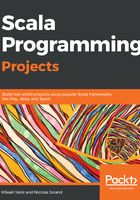
Implementing the Main method
Now that all our tests are green, we can implement the main method. The implementation becomes trivial as all the code is already in the test:
object Main extends App {
val persons = List(
Person(firstName = "Akira", lastName = "Sakura", age = 12),
Person(firstName = "Peter", lastName = "Müller", age = 34),
Person(firstName = "Nick", lastName = "Tagart", age = 52))
val adults = Person.filterAdult(persons)
val descriptions = adults.map(p => p.description).mkString("\n\t")
println(s"The adults are \n\t$descriptions")
}
The first thing is to define a list of Person, so that Person.filterAdult() is used to remove all the persons, not the adults. The adults variable is a list of Person, but I would like to transform this list of Person into a list of the description of the Person. To perform this operation, the map function of the collection is used. The map function transforms each element of the list by applying the function in the parameter.
The notation inside the map() function defines an anonymous function that takes p as the parameter. The body of the function is p.description. This notation is commonly used whenever a function takes another function as an argument.
Once we have a list of descriptions, we create a string with the mkString() function. It concatenates all the elements of the list using the special character \n\t, which are respectively the carriage return and the tab character.
Finally, we perform the side effect, which is the print on the console. To print in the console, the println alias is used. It is a syntactic sugar for System.out.println.